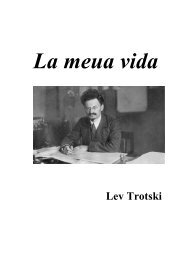the produce <strong>of</strong> his own labour, creates, indeed, use values, but not commodities. In order toproduce the latter, he must not only produce use values, but use values for others, social usevalues. (And not only for others, without more. The mediaeval peasant produced quit-rent-cornfor his feudal lord and tithe-corn for his parson. But neither the quit-rent-corn nor the tithe-cornbecame commodities by reason <strong>of</strong> the fact that they had been produced for others. To become acommodity a product must be transferred to another, whom it will serve as a use value, bymeans <strong>of</strong> an exchange.) Lastly nothing can have value, without being an object <strong>of</strong> utility. If thething is useless, so is the labour contained in it; the labour does not count as labour, andtherefore creates no value.§2 Two-Fold Character <strong>of</strong> Labour Embodied in CommoditiesAt first sight a commodity presented itself to us as a complex <strong>of</strong> two things – use value andexchange value. Later on, we saw also that labour, too, possesses the same tw<strong>of</strong>old nature; for,so far as it finds expression in value, it does not possess the same characteristics that belong to itas a creator <strong>of</strong> use values. I was the first to point out and to examine critically this tw<strong>of</strong>oldnature <strong>of</strong> the labour contained in commodities. As this point is the pivot on which a clearcomprehension <strong>of</strong> political economy turns, we must go more into detail.Let us take two commodities such as a coat and 10 yards <strong>of</strong> linen, and let the former be doublethe value <strong>of</strong> the latter, so that, if 10 yards <strong>of</strong> linen = W, the coat = 2W.The coat is a use value that satisfies a particular want. Its existence is the result <strong>of</strong> a special sort<strong>of</strong> productive activity, the nature <strong>of</strong> which is determined by its aim, mode <strong>of</strong> operation, subject,means, and result. The labour, whose utility is thus represented by the value in use <strong>of</strong> itsproduct, or which manifests itself by making its product a use value, we call useful labour. Inthis connection we consider only its useful effect.As the coat and the linen are two qualitatively different use values, so also are the two forms <strong>of</strong>labour that produce them, tailoring and weaving. Were these two objects not qualitativelydifferent, not produced respectively by labour <strong>of</strong> different quality, they could not stand to eachother in the relation <strong>of</strong> commodities. Coats are not exchanged for coats, one use value is notexchanged for another <strong>of</strong> the same kind.To all the different varieties <strong>of</strong> values in use there correspond as many different kinds <strong>of</strong> usefullabour, classified according to the order, genus, species, and variety to which they belong in thesocial division <strong>of</strong> labour. This division <strong>of</strong> labour is a necessary condition for the production <strong>of</strong>commodities, but it does not follow, conversely, that the production <strong>of</strong> commodities is anecessary condition for the division <strong>of</strong> labour. In the primitive Indian community there is socialdivision <strong>of</strong> labour, without production <strong>of</strong> commodities. Or, to take an example nearer home, inevery factory the labour is divided according to a system, but this division is not brought aboutby the operatives mutually exchanging their individual products. Only such products canbecome commodities with regard to each other, as result from different kinds <strong>of</strong> labour, eachkind being carried on independently and for the account <strong>of</strong> private individuals.To resume, then: In the use value <strong>of</strong> each commodity there is contained useful labour, i.e.,productive activity <strong>of</strong> a definite kind and exercised with a definite aim. Use values cannotconfront each other as commodities, unless the useful labour embodied in them is qualitativelydifferent in each <strong>of</strong> them. In a community, the produce <strong>of</strong> which in general takes the form <strong>of</strong>commodities, i.e., in a community <strong>of</strong> commodity producers, this qualitative difference betweenthe useful forms <strong>of</strong> labour that are carried on independently by individual producers, each ontheir own account, develops into a complex system, a social division <strong>of</strong> labour.Anyhow, whether the coat be worn by the tailor or by his customer, in either case it operates asa use value. Nor is the relation between the coat and the labour that produced it altered by thecircumstance that tailoring may have become a special trade, an independent branch <strong>of</strong> thesocial division <strong>of</strong> labour. Wherever the want <strong>of</strong> clothing forced them to it, the human race madeclothes for thousands <strong>of</strong> years, without a single man becoming a tailor. But coats and linen, likeevery other element <strong>of</strong> material wealth that is not the spontaneous produce <strong>of</strong> Nature, mustinvariably owe their existence to a special productive activity, exercised with a definite aim, anactivity that appropriates particular nature-given materials to particular human wants. So fartherefore as labour is a creator <strong>of</strong> use value, is useful labour, it is a necessary condition,independent <strong>of</strong> all forms <strong>of</strong> society, for the existence <strong>of</strong> the human race; it is an eternal nature-
imposed necessity, without which there can be no material exchanges between man and Nature,and therefore no life.The use values, coat, linen, &c., i.e., the bodies <strong>of</strong> commodities, are combinations <strong>of</strong> twoelements – matter and labour. If we take away the useful labour expended upon them, a materialsubstratum is always left, which is furnished by Nature without the help <strong>of</strong> man. The latter canwork only as Nature does, that is by changing the form <strong>of</strong> matter. Nay more, in this work <strong>of</strong>changing the form he is constantly helped by natural forces. We see, then, that labour is not theonly source <strong>of</strong> material wealth, <strong>of</strong> use values produced by labour. As William Petty puts it,labour is its father and the earth its mother.Let us now pass from the commodity considered as a use value to the value <strong>of</strong> commodities.By our assumption, the coat is worth twice as much as the linen. But this is a mere quantitativedifference, which for the present does not concern us. We bear in mind, however, that if thevalue <strong>of</strong> the coat is double that <strong>of</strong> 10 yds <strong>of</strong> linen, 20 yds <strong>of</strong> linen must have the same value asone coat. So far as they are values, the coat and the linen are things <strong>of</strong> a like substance, objectiveexpressions <strong>of</strong> essentially identical labour. But tailoring and weaving are, qualitatively, differentkinds <strong>of</strong> labour. There are, however, states <strong>of</strong> society in which one and the same man doestailoring and weaving alternately, in which case these two forms <strong>of</strong> labour are meremodifications <strong>of</strong> the labour <strong>of</strong> the same individual, and not special and fixed functions <strong>of</strong>different persons, just as the coat which our tailor makes one day, and the trousers which hemakes another day, imply only a variation in the labour <strong>of</strong> one and the same individual.Moreover, we see at a glance that, in our capitalist society, a given portion <strong>of</strong> human labour is,in accordance with the varying demand, at one time supplied in the form <strong>of</strong> tailoring, at anotherin the form <strong>of</strong> weaving. This change may possibly not take place without friction, but take placeit must.Productive activity, if we leave out <strong>of</strong> sight its special form, viz., the useful character <strong>of</strong> thelabour, is nothing but the expenditure <strong>of</strong> human labour power. Tailoring and weaving, thoughqualitatively different productive activities, are each a productive expenditure <strong>of</strong> human brains,nerves, and muscles, and in this sense are human labour. They are but two different modes <strong>of</strong>expending human labour power. Of course, this labour power, which remains the same under allits modifications, must have attained a certain pitch <strong>of</strong> development before it can be expended ina multiplicity <strong>of</strong> modes. But the value <strong>of</strong> a commodity represents human labour in the abstract,the expenditure <strong>of</strong> human labour in general. And just as in society, a general or a banker plays agreat part, but mere man, on the other hand, a very shabby part, so here with mere humanlabour. It is the expenditure <strong>of</strong> simple labour power, i.e., <strong>of</strong> the labour power which, on anaverage, apart from any special development, exists in the organism <strong>of</strong> every ordinaryindividual. Simple average labour, it is true, varies in character in different countries and atdifferent times, but in a particular society it is given. Skilled labour counts only as simple labourintensified, or rather, as multiplied simple labour, a given quantity <strong>of</strong> skilled being consideredequal to a greater quantity <strong>of</strong> simple labour. Experience shows that this reduction is constantlybeing made. A commodity may be the product <strong>of</strong> the most skilled labour, but its value, byequating it to the product <strong>of</strong> simple unskilled labour, represents a definite quantity <strong>of</strong> the latterlabour alone. The different proportions in which different sorts <strong>of</strong> labour are reduced tounskilled labour as their standard, are established by a social process that goes on behind thebacks <strong>of</strong> the producers, and, consequently, appear to be fixed by custom. For simplicity’s sakewe shall henceforth account every kind <strong>of</strong> labour to be unskilled, simple labour; by this we dono more than save ourselves the trouble <strong>of</strong> making the reduction.Just as, therefore, in viewing the coat and linen as values, we abstract from their different usevalues, so it is with the labour represented by those values: we disregard the difference betweenits useful forms, weaving and tailoring. As the use values, coat and linen, are combinations <strong>of</strong>special productive activities with cloth and yarn, while the values, coat and linen, are, on theother hand, mere homogeneous congelations <strong>of</strong> undifferentiated labour, so the labour embodiedin these latter values does not count by virtue <strong>of</strong> its productive relation to cloth and yarn, butonly as being expenditure <strong>of</strong> human labour power. Tailoring and weaving are necessary factorsin the creation <strong>of</strong> the use values, coat and linen, precisely because these two kinds <strong>of</strong> labour are<strong>of</strong> different qualities; but only in so far as abstraction is made from their special qualities, only
- Page 4:
égime, which has been through its
- Page 7:
sins of all state forms. That this
- Page 13 and 14:
It has not occurred to any one of t
- Page 15 and 16:
gradually accumulated small capital
- Page 17 and 18:
from this nonsensical ‘prehistory
- Page 19 and 20:
property: the nucleus, the first fo
- Page 21 and 22:
which produces in all nations simul
- Page 23 and 24:
[8. The Inconsistency of the Ideali
- Page 25 and 26:
The ‘essence’ of the fish is it
- Page 27 and 28:
hence of the relationships which ma
- Page 29 and 30:
labour. In the first case, therefor
- Page 31 and 32:
production and commerce soon calls
- Page 33 and 34:
period begins with the Navigation L
- Page 35 and 36:
more advanced countries, still have
- Page 37 and 38:
over against the individuals, so th
- Page 39 and 40:
eality is only a product of the pre
- Page 41 and 42:
never became more than a city; its
- Page 43 and 44:
Only at this stage does self-activi
- Page 45 and 46:
Modern industry has established the
- Page 47 and 48:
these crises, there breaks out an e
- Page 49 and 50:
Further, as we have already seen, e
- Page 51 and 52:
abolish that; the development of in
- Page 53 and 54:
For the rest, nothing is more ridic
- Page 55 and 56:
III. Socialist and Communist Litera
- Page 57 and 58:
conscious of having overcome “Fre
- Page 59 and 60:
The undeveloped state of the class
- Page 61 and 62:
The Paris CommuneAddress to the Int
- Page 63 and 64:
priests were sent back to the reces
- Page 65 and 66:
pregnant. In the full consciousness
- Page 67 and 68: subjected Versailles and the rest o
- Page 69 and 70: The Eighteenth Brumaire of Louis Bo
- Page 71 and 72: For the rest, every fair observer,
- Page 73 and 74: that here “bourgeois republic”
- Page 75 and 76: Eternalization of historic relation
- Page 77 and 78: and becomes a direct object and ser
- Page 79 and 80: each supplies the other with its ob
- Page 81 and 82: generally. The question evidently b
- Page 83 and 84: is thus the only reality, the movem
- Page 85 and 86: smudge over all historical differen
- Page 87 and 88: elations. Thus e.g. the relation of
- Page 89 and 90: a rise of wages, because every reac
- Page 91 and 92: equally spent upon all articles of
- Page 93 and 94: Apart from some years of failing ha
- Page 95 and 96: enable a currency to adapt itself t
- Page 97 and 98: Smith and his French predecessors h
- Page 99 and 100: conditions of production, with a gi
- Page 101 and 102: in a commodity constitutes its valu
- Page 103 and 104: y working which the working man wou
- Page 105 and 106: just seen that the surplus value co
- Page 107 and 108: increased value of his labour, like
- Page 109 and 110: altogether, is sure to have his wag
- Page 111 and 112: theory, which consists in putting a
- Page 113 and 114: Preface to A Contribution to the Cr
- Page 115 and 116: Capital, Volume I (1867)From the Pr
- Page 117: A use value, or useful article, the
- Page 121 and 122: embodiments of one identical social
- Page 123 and 124: abstract. The twofold social charac
- Page 125 and 126: ased on the production of commoditi
- Page 127 and 128: Capital Vol. III. Chapter 2. The Ra
- Page 129 and 130: specific relationship to surplus-va


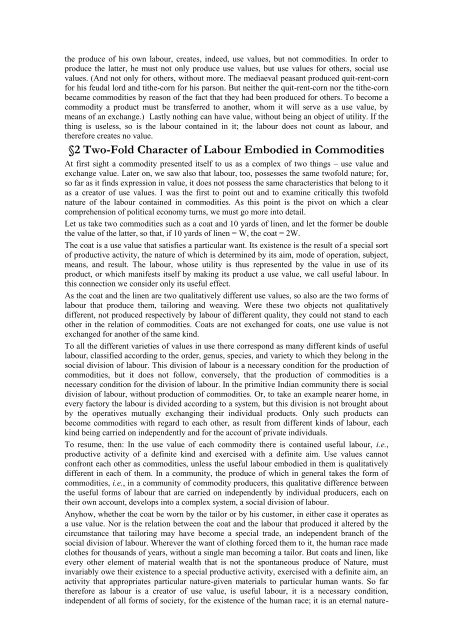
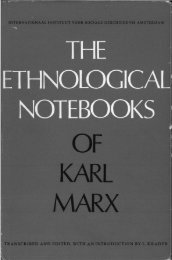

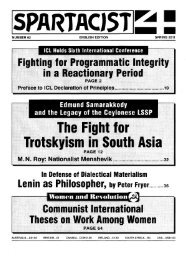

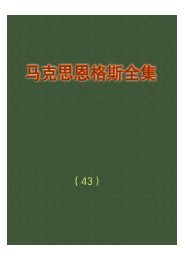
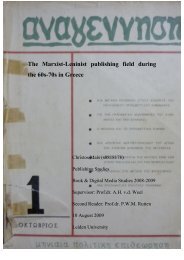
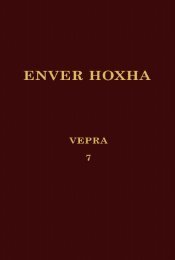
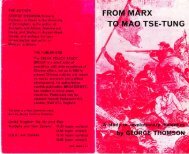

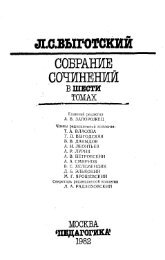
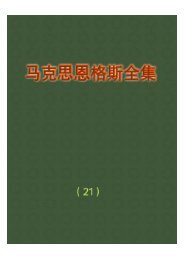
![tyf Enf=O=n]lgg](https://img.yumpu.com/47584932/1/190x245/tyf-enfonlgg.jpg?quality=85)
